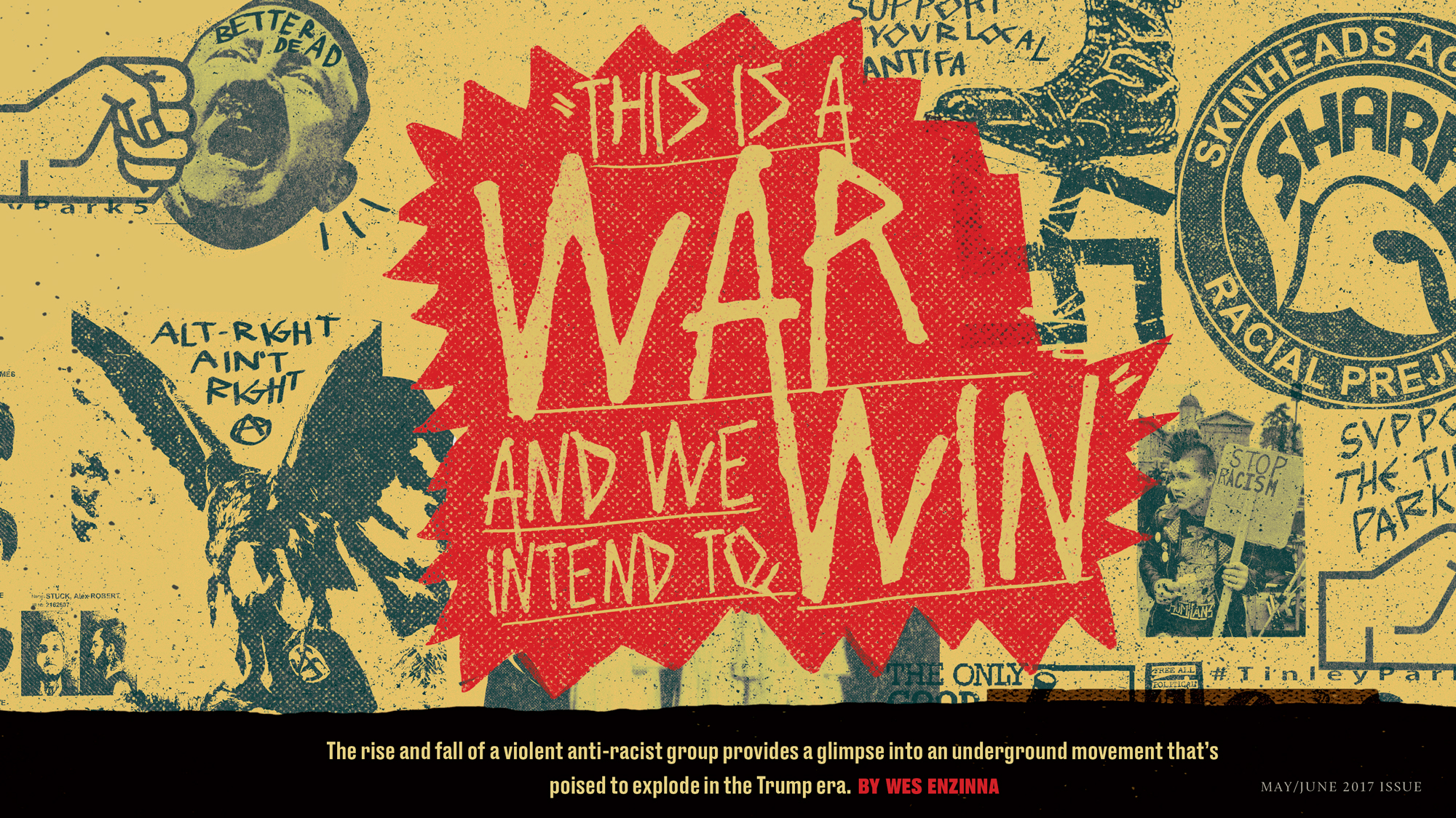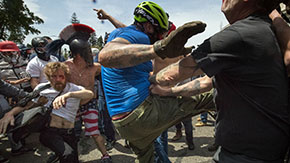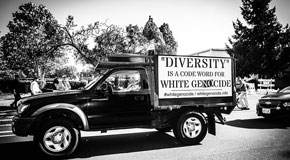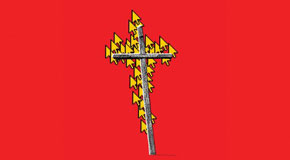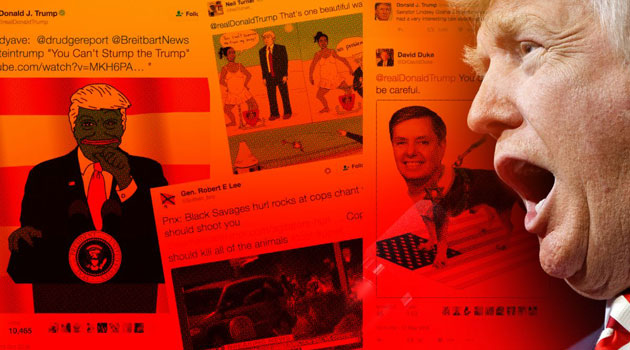At lunchtime on May 19, 2012, 18 masked men and women shouldered through the front door of the Ashford House restaurant in Tinley Park, Illinois, a working-class suburb of Chicago. Some diners mistook the mob for armed robbers. Others thought they might be playing a practical joke. But Steven Speers, a stalactite-bearded 33-year-old who had just sat down for appetizers at a white nationalist meet and greet, had a hunch who they were. The gang filing in with baseball bats, police batons, hammers, and nunchucks were members of Anti-Racist Action (ARA) and the Hoosier Anti-Racist Movement (HARM), two groups dedicated to violently confronting white supremacists.
“Hey, bitches!” one of the anti-racists shouted before charging Speers’ table. “ARA is going to fuck this place up!”
Speers stood up and warned his seven companions to prepare to fight. His girlfriend, Beckie Williams, who had organized the lunchtime gathering on the white supremacist website Stormfront, grabbed a butter knife. Francis Gilroy, a homeless man who had driven up from Florida to find “work for whites,” as an online ad for the meeting promised, tried to pull the attackers off his companions. Williams was clubbed on the arm. Speers was hit on the head so hard he vomited.
An 80-year-old woman celebrating her granddaughter’s high school graduation at a nearby table was also pushed to the floor. A retired cop who believed he was witnessing a terrorist attack used a chair to knock out one of the masked intruders. That’s when they ran off, dragging their dazed companion.
In less than two minutes, the anti-racists had unleashed a flurry of destruction. A mosaic of smashed glass covered the floor. Blood polka-dotted the ceiling. Three people required medical care.
One group of attackers raced away in a cherry red Dodge Neon. Jason Sutherlin, a 33-year-old with the words “TIME BOMB” tattooed across his knuckles, rode shotgun. His half-brother Dylan drove, and his half-brother Cody, along with their cousin John Tucker, squeezed into the backseat with 22-year-old Alex Stuck, who’d been decked in the restaurant. They sped toward Interstate 80, which would take them home to central Indiana.
An off-duty police sergeant who’d heard a radio call about the attack spotted the Neon and turned on her siren. When she looked inside the parked car, amid the sweaty men she saw a baton, a baseball cap that said “Anti-Racist,” and a black and red scarf spelling out “HARM.” The men were arrested and charged with felony mob action and aggravated battery, which together carried up to seven years behind bars. (Speers and Gilroy were also arrested—Speers for a charge of possessing child pornography.)
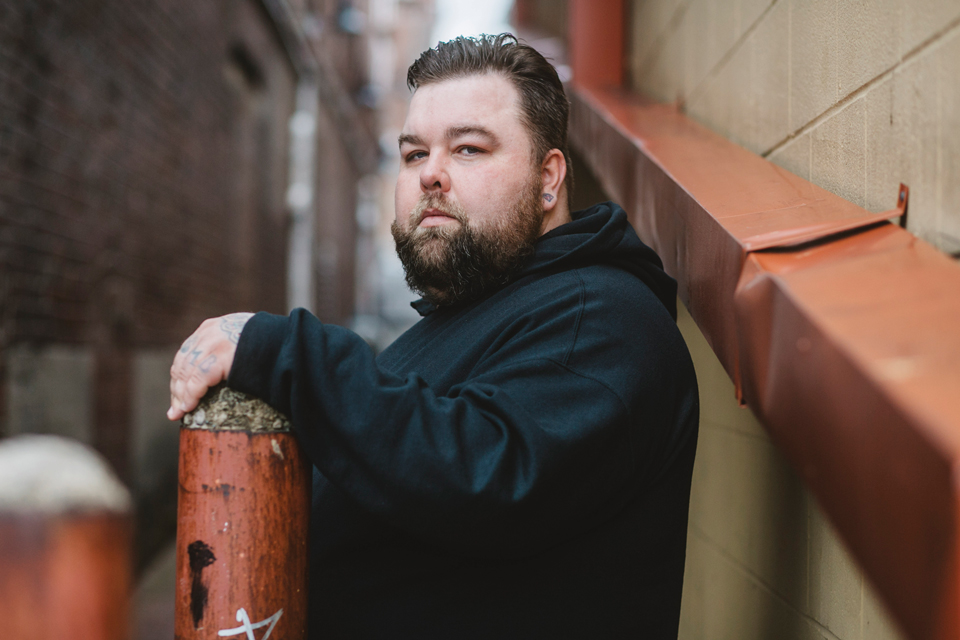
Sutherlin and his four compatriots would soon come to be known as the Tinley Park Five. Though they had launched the Hoosier Anti-Racist Movement just six months earlier, the attack would make them the public faces of a small yet militant movement that had been waging war on right-wing extremists for decades. HARM was part of Anti-Racist Action, a national group that had spent more than 20 years trying to expose and combat radical right-wing activity with tactics that ranged from counseling kids in neo-Nazi gangs to harassment and physical violence. Most of their actions received little attention, though they occasionally made headlines, like after the 2002 Battle of York, where ARA members attacked a white supremacist march in a Pennsylvania town, or the time in 2009 when pepper-spray-wielding ARA members broke up a New York City speech by the British Holocaust denier David Irving. But mostly, this war was invisible beyond the predominantly white working-class youths caught up in it.
As the election of Donald Trump has ushered white supremacists and their ideas from the fringes to the mainstream, their most militant foes have also come out of the shadows. On Inauguration Day, Richard Spencer, the white nationalist who coined the term “alt-right,” was punched in the face on a Washington, DC, street corner. The blow was caught on video, spawning countless remixes and a debate over the ethics and efficacy of “Nazi punching.” That same night, a Trump supporter shot and wounded an anti-fascist, or “antifa,” who was protesting a speech by Breitbart provocateur Milo Yiannopoulos at the University of Washington in Seattle. Less than two weeks later, “black bloc” protesters in Berkeley, California, helped force the cancellation of another Yiannopoulos speech, setting fires, smashing windows, and punching a Milo fan. Nationwide, new militant groups like Redneck Revolt are recruiting the next generation of activists who believe that white liberals are not up to the challenge of beating back right-wing extremists. The story of HARM’s rise and fall is a prequel to this moment, and a revealing tale about an underground war that’s been simmering for years and may now be poised to explode.
The seed for HARM was planted in People’s Park, a tangle of trees and footpaths in downtown Bloomington, Indiana, where in 1968 an African American graduate student named Clarence Turner opened a small store called the Black Market. In a state with a long history of white supremacism (in 1925, nearly one-third of all adult white males there belonged to the Ku Klux Klan, and the governor was a sympathizer), the shop celebrated African and African American culture by selling dashikis and Malcolm X speeches. A few months after it opened, two Klan members firebombed it on Christmas. “This will not be an open season on niggers,” Turner shouted during a rally in front of the ashen skeleton of his shop.
By the 1990s, People’s Park had become a hangout spot for punks, ravers, hippies, petty drug dealers, and college kids looking to score. It was there around 1996 that Jason Sutherlin met Telly, another teen from a nearby town. Telly introduced Sutherlin to Nomad, a hulking, half-Puerto Rican tattoo artist. (These names are aliases that they asked me to use to avoid being targeted by white supremacists; the investigation into the Tinley Park assaults is ongoing.) Long before they would become leaders of the local anti-racist movement, the three teens “chased the same cute punk girls,” Sutherlin recalls. “At first, they were my competition, but then we became pals.”
The trio shared a love of hip-hop and punk and a hatred for bullies. It was at house parties and concerts that they got their first introduction to Indiana’s numerous white supremacist gangs—specifically, the Hammerskins and the Vinlanders Social Club. Sutherlin recalls attending a show where a Hammerskin stabbed a Latino kid. At another show, concertgoers tried to kick out a group of neo-Nazis, one of whom fired a gun into the air. (More recently, three Vinlanders nearly beat a homeless black man to death in Indianapolis in 2007.) Sutherlin was shocked by the neo-Nazis’ boldness, but he was just as impressed by how the older punks stood up to them. “That culture of not taking any shit seeped into my consciousness.”
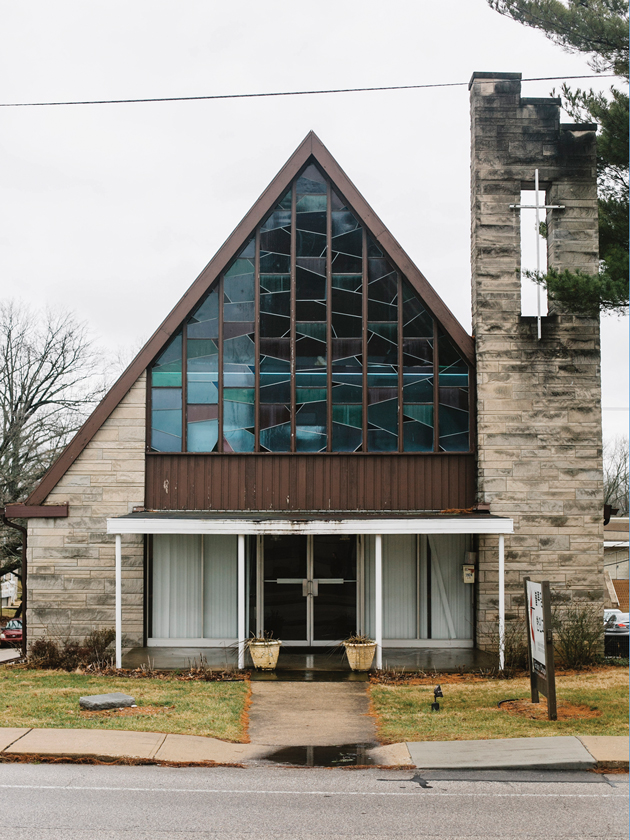
Sutherlin had grown up in a diverse, working-class family that moved frequently between Indiana, Texas, and Florida. “We were crazy white trash, but my mom ran a very multicultural household,” he said. He had a gay Latino babysitter and his younger sister’s dad is black. Sutherlin recalled walking down the street with her near their home outside Bloomington when she was four. “Look,” a man shouted from the window of his pickup. “He’s got his own little nigger!” When the 14-year-old Sutherlin launched a bottle of Snapple at the truck, the man jumped out and beat him up. “In that moment, I realized that if there’s anything in life worth throwing down over,” he said, “that was it.”
In July 1999, a 21-year-old Indiana University student who had fallen under the sway of a neo-Nazi cult called the World Church of the Creator went on a two-state, three-day shooting spree, wounding nine people and killing two, including a Korean graduate student in Bloomington. Still, Sutherlin and his friends weren’t overtly interested in politics yet—they just liked hanging out in the park, going to shows, drinking, and getting into fights. Sutherlin describes himself during his teens and early 20s as a “hoodrat.” One night in 1999, after he’d dropped out of school, he burglarized a house, stealing several computers to get money to buy cocaine. He was sentenced to two years. An acquaintance who was also an inmate at the same facility later joined the prison branch of the Vinlanders Social Club. “He wasn’t even racist,” Sutherlin said, “but I think the power of the group appealed to him. If you’re a disaffected young man, any strong masculine identity will hold sway over you.”
Sutherlin became active in politics after getting out of prison and having a child. “Bringing a son into this world made me feel like I had to make things better for him,” he said. Punk, rap lyrics, and his family’s diversity had fostered his interest in left-wing ideas, but now he read voraciously about slavery, capitalism, and sexism. Michelle Alexander’s book The New Jim Crow, which documents the link between race and mass incarceration, “blew my mind.” He became fascinated by the militant 19th-century abolitionist John Brown. He went on a diet and lost nearly 150 pounds.
When Barack Obama was elected president in 2008, Sutherlin took it as a sign that America might finally be reckoning with its racist past. “He was the first president I ever believed in,” he says. “Like, I was telling my family to vote for him.” But after Obama’s election, the political climate seemed to sour and the racial progress Sutherlin had hoped for never materialized. “America just would not accept a black man as its leader. It enraged me to fully realize that.”
Fanning the flames of Sutherlin’s anger was the emergence of the tea party and birtherism, and the “failure of mainstream Democratic or Republican politicians to aggressively challenge” these movements’ racist and nativist messages. This frustration led him to People’s Park, where a small crowd gathered at the former site of the Black Market one night in October 2011. Just three weeks after Occupy Wall Street took over New York’s Zuccotti Park, Occupy Bloomington was born. Sutherlin helped build a kitchen and cook communal meals, and he didn’t sleep for two days. He was thrilled to be involved in activism of some kind, even if it wasn’t directly addressing racism.
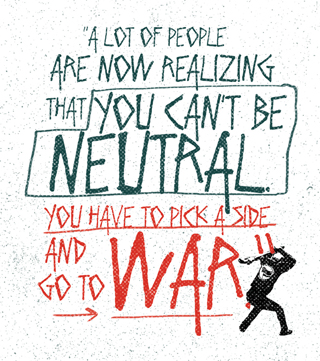
Toward the end of the year, Thomas Buhls, a former Marine and organizer for the Knights, the public wing of the Ku Klux Klan, showed up around People’s Park handing out recruitment pamphlets and talking about “white genocide.” Buhls was part of a new wave of young white supremacists who pioneered the recruitment approach since adopted by the so-called alt-right: rebranding white nationalism not as a philosophy of racial superiority, but as a common-sense extension of identity politics in which the white working class is portrayed as victims of immigration, affirmative action, and multiculturalism. In this world-view, white anti-racists were an especially loathsome threat to racial solidarity. “If I tell the obvious truth about the ongoing program of genocide against my race, the white race, Liberals and respectable conservatives agree that I am a naziwhowantstokillsixmillionjews,” wrote Robert Whitaker, a former Reagan administration aide, in his “Mantra,” a mini-manifesto that appeared online in 2006 and has served as a touchstone for white nationalists. “They say they are anti-racist. What they are is anti-white. ‘Anti-racist’ is a code word for anti-white.”
“Buhls was telling people the recession happened because of the Jew bankers, because the Latinos were stealing jobs,” Sutherlin remembers. He and Telly would confront Buhls when they got the chance, and Sutherlin told him not to bother people in the park. “His audacity, man, of showing up at the spot where the Black Market had been firebombed.”
“I wasn’t sure if I was racist or anti-racist,” recalls Alex Stuck. “I just knew I was pissed off.” A high school dropout from Terre Haute, Indiana, who also participated in Occupy Bloomington, Stuck worked at a pizza shop beneath the pub where Sutherlin was a bartender and bouncer. Stuck had a cockatiel Mohawk, a teardrop inked beneath his right eye, and an underbite reminiscent of a French bulldog. “I was your average dumb kid,” he says. “I’d tell a racist joke or use a racist slur.” But Sutherlin began to school him about white privilege, sexism, and structural racism. “Before that, I was a muggle,” Stuck says, referring to the term for Harry Potter characters without magical powers.
The magic Sutherlin introduced him to was the history of the secret war between anti-racists and white supremacists. Like most wars, this one had its own martyrs and heroes. There was the tragedy of Greensboro, North Carolina, where in 1979 Klansmen and neo-Nazis opened fire on a “Death to the Klan” rally, killing five participants. There were the Baldies, a 1980s Minneapolis street crew, whose shaved heads, bomber jackets, boots, and braces mirrored the attire of the racist skinheads they booted out of town. And then there was Anti-Racist Action, which merged the moralism of America’s abolitionist tradition with the nihilism of punk rock and viewed the culture war as a literal war on racists, sexists, and homophobes, whom they denounced as fascists. “Racism is an idea,” an anonymous ARA member said in the 2000 documentary Invisible Revolution, but “fascism is an idea mixed with action. It took fascism to establish Jim Crow and before that, slavery…Anti-Semitism has been around a long time, but it took fascism to [make] the Holocaust…When you cross that threshold, you negate your rights to a calm, collective conversation.”
If ARA was the brawn of the anti-racist movement, its most prominent brain was Noel Ignatiev, a Marxist, an ex-steelworker, and a former lecturer for Harvard University’s African American studies department. He founded a journal, Race Traitor, as a vehicle for his theories about how to attack and erode white privilege. Anti-racist whites must commit “treason to whiteness” by rejecting the benefits skin color confers upon them, Ignatiev argued. “Be reverse Oreos,” he told the New York Times in 1997. “Defy the rules of whiteness—flagrantly, publicly. When someone makes a racial slur in your presence, say, ‘You probably think I’m white because I look white.'” He added that “challenging people on their whiteness can lead to harsh confrontations, even blows.” Breitbart described him as the “Harvard professor [who] calls for the ‘destruction’ of the ‘white race.'”
Sutherlin, Telly, and Nomad cited this legacy as inspiration for the group they formed in the winter of 2011, just before Occupy Bloomington was evicted from People’s Park. “The feeling was that Occupy had been too moderate and unfocused,” says Sutherlin’s cousin John Tucker, who worked with Sutherlin as a bouncer. He credits his interest in HARM to teenage run-ins with neo-Nazis and to the times he heard his mother, who has a dark complexion, being called “wetback” and “squaw” by strangers in Bloomington. “This was going to be something more effective,” Tucker said. “Protesting and camping is nice, but this was going to have results.”
At HARM’s first official meeting, a few dozen people showed up at Sutherlin’s apartment with potluck dishes and beer. Telly stood before the crowd and announced the new group’s name and mission. Adopting Anti-Racist Action’s four-point platform, HARM promised to fight racists with direct action, eschewing protests or legislative efforts in favor of, say, hacking neo-Nazis’ email accounts, providing security at gay pride parades, and exposing the shady pasts of bigoted candidates. “This is a war,” Telly said, “and we intend to win.”
That’s when all but about 10 people left. “Some of them were hipster liberals,” said Stuck. “Once it came down to the nitty-gritty and we started discussing tactics, they were like, ‘We don’t wanna be a part of this.'”
Those who stayed included Tucker, who’d never been involved in politics before, and Sutherlin’s affable 23-year-old half-brother, Cody. Nomad arrived later that night. Stuck recalls seeing him—muscular as a middleweight, his head Bic-razored, his throat adorned with a tattoo of a switchblade—and thinking, “That’s who I want to be.” “I was a disenfranchised white youth,” Stuck says, “and thank God that [HARM] got to me first. I could have easily went the opposite direction.”
Nomad had that exact fear about his 14-year-old son, who had recently come home with a neo-Nazi recruitment flyer. White supremacists had even shown up at the tattoo parlor where Nomad worked and tried to recruit him, not realizing he was a militant anti-racist—and half Puerto Rican. “They are poisoning these kids,” Nomad said.
Telly was particularly alarmed by the growing acceptance of extreme right-wing ideas and figures. “It was terrifying,” he said. The birther movement and Arizona’s 2010 anti-immigrant law were “barely veiled racist sentiments that sounded like stuff white supremacists would advocate, not what members of the Republican Party would typically find acceptable.” Telly recalled J.T. Ready, an Arizona Republican committeeman and a former member of the National Socialist Movement who killed his family and himself after the FBI began investigating his border militia group for the murder of undocumented immigrants. There was also Jack Hunter, who had worked as an aide to Sen. Rand Paul (R-Ky.) until it came out that he’d made pro-Confederate statements and written that “John Wilkes Booth’s heart was in the right place.” These people didn’t have much influence, Telly acknowledged, but “it was fucking insane that they had any influence whatsoever. Things had gone so far to the right, and we wanted to pull them back to the left.”
With its core members assembled, HARM planned an action: It would confront Buhls, who was holding a “European Heritage” rally in downtown Bloomington. In preparation, the activists lifted weights in Sutherlin’s garage “to beef up so we could break bones better,” says Stuck, half-seriously. On the day of the rally, in April 2012, more than 100 people came out to protest Buhls, who showed up with just one friend. The HARM members didn’t have a concrete plan to challenge Buhls, and before they could do anything two protesters ran up and punched him. His “Celebrate White Heritage” sign capsized into a sea of counterprotesters. Police whisked him away in a patrol car for his own safety.
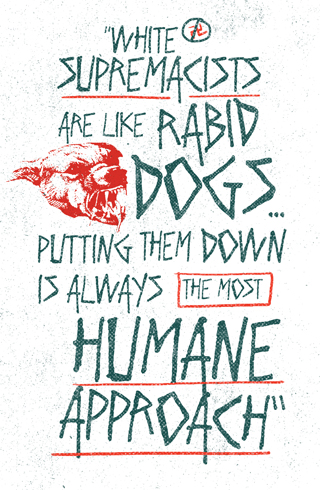
A few weeks later, HARM stormed the restaurant in Illinois. While Sutherlin and the rest of the Tinley Park Five sat in jail, their comrades found their next target: the newly formed White Student Union at Indiana University. Matthew Heimbach, a white nationalist leader from Maryland, had pioneered the first White Student Union at Towson University outside Baltimore before helping spread the concept to other schools. Bloomington’s White Student Union announced its presence on campus by planning an “American White History Month.”
But less than a week after the White Student Union made its debut, a disturbing notice was posted on the group’s Facebook page by its founder, an IU undergrad:
I just spent all night in the hospital.
While walking down 10th…a blue van pulled up and four figures poured out of the vehicle…All of them wore all black clothing and had either ski masks or bandanas covering their faces…
What’s up…? That’s the only thing they said. I got hit in the head with something from behind. I fell down and told them that was enough. At this point all…of them proceeded to kick me for what felt like hours. At some point I passed out. I didn’t think I would ever wake up again.
None of it was true—it was an elaborate psyops scheme. HARM had plastered flyers all over Bloomington denouncing the White Student Union’s founder as a racist and then promised to stop only if he handed over access to the group’s Facebook page. Amazingly, he did. Then HARM invented the story of the beating to elicit notes of sympathy from other white supremacists. Once the post was up, they “doxed” those who replied, posting their real names and email addresses online.
“Though we support direct action against white supremacy,” an anonymous HARM member gloated on the group’s website after revealing the hoax, “we also believe in proportional responses and it is our belief that this fictitious action would have been overkill.” In other words, actually beating up the college kid who started the White Student Union would have been a step too far, but harassing him and outing his sympathizers was not. Heimbach “found a young naive conservative kid and turned him into the next battle in the war against racial supremacy,” the HARM member wrote, adding that the student had agreed to disband the White Student Union as a result of the hacking. “White supremacists are like rabid dogs…Just like rabid dogs, putting them down is always the most humane approach.”
I met Telly and Nomad in Columbus, Ohio, several months after the Tinley Park attack. Sutherlin and his brothers, his cousin, and Stuck were in Chicago awaiting trial, and Telly and Nomad were participating in a fundraiser to pay bail. They led me to a carriage house behind a “big-ass, beautiful mansion,” as Nomad described it, where a crowd of about 50 people greeted us. Many were HARM and ARA members, and I wondered if any of the remaining 13 fugitives were among them. (I never found out.) They were dressed in Mad Max-style punk garb—black jeans, black hoodies, bomber jackets, and combat boots, with neck and face tattoos, septum piercings, and rainbow-colored bandannas. They included a few African Americans and a dozen women. As Bob Fitrakis, a political-science professor and voting rights activist who hosted the event, wrote, they “exuded an aura that made the Weathermen look like the Brady Bunch.”
Fitrakis, a paunchy man with a ducktail mullet, was running for Congress as the candidate of the Green Party, which had co-sponsored the evening with ARA. His supporters, who had paid $25 to attend, mingled awkwardly with the radicals. Circulating among them was the Green Party’s then-vice presidential candidate, an anti-poverty activist named Cheri Honkala. “Dude,” Nomad said to me after a woman wearing a pearl brooch offered him a glass of zinfandel on a silver tray. The switchblade tattooed across his throat wiggled as he spoke. “This is a little out of my league.”
“These kids are the future,” said a sweaty, elderly man who asked that I not use his name because he was a “prominent professor.” He wore a black blazer over a T-shirt with a peace sign. “This is what the left needs—working-class, radical youth who aren’t afraid to get their hands dirty and scare the bejesus out of the teabaggers!”
“I guess there’s a time and a place for everything, even electoral politics,” Nomad said as he handed me a PBR, glaring at the clean-cut and middle-aged partygoers around us. He took a swig from a bottle of Southern Comfort he’d stashed in his back pocket. “But—and I hate to use gendered language like this—liberals are fucking pussies, man. Sometimes you’ve got to put on the big-boy boots and stomp through some mud.”
After Honkala made a speech about her work as a housing activist in Philadelphia, Telly and two other ARA members sat at the front of the room and described what had happened at the Ashford House. Nomad, standing beside me, snorted tearfully into a red handkerchief when Telly read a letter Jason Sutherlin had sent from jail. “People might think our actions are extreme,” Telly told the crowd, “but these guys”—neo-Nazis—”are often so far beyond the law that they don’t respond to legal appeals. They don’t care if hate crime legislation is enacted; it makes no difference to them. The situation in America has reached a critical tipping point, and we need to fight back with whatever tactics are effective at sending these guys back into the caves they crawled out of.”
“Right on, brother,” a snowy-haired man said.
Other Green Party members golf-clapped. The professor in the black blazer raised his champagne glass.
A hand suddenly shot up in the crowd. “Am I hearing you right?” asked an elegant African American woman with a bundle of silver-streaked hair and a “No War in Iraq” button on her straw purse. “You guys advocate violence?” She’d never heard of HARM or ARA and had been attracted by their names, she explained, but weren’t they just as bad as the people they were fighting? “Doesn’t your approach make you just like the Nazis?”
“Bullshit,” an ARA activist fake-sneezed, flashing a shit-eating smile. The questioner stormed out of the room. Telly ran a hand over his shaved head and sighed. “We’re not remotely the same,” he told the remaining crowd. “We support a diversity of tactics.” He reminded listeners that most of ARA’s actions were nonviolent—removing swastika tattoos from ex-convicts, counseling juvenile offenders, providing security at protests. “Violence is never our default response, and it’s a tiny fraction of what we do,” he said. “But it is one weapon in our tool kit. We’re not afraid to acknowledge when nonviolence is obviously not working. What you’re doing, what the liberal left is doing, frankly isn’t working.”
Five months later, I met Jason Sutherlin at East Moline Correctional Center, a turreted fortress circled by razor wire rising out of the cornfields of western Illinois, where he’d been sentenced to six years following a plea deal. His brothers, his cousin, and Stuck were sent elsewhere in the state to serve terms ranging from three and a half to six years. (A sixth Ashford House attacker, 28-year-old Jason Hammond, was later arrested and sentenced to three and a half years. His twin brother, Jeremy, is serving a 10-year sentence for hacking the security company Stratfor.) The rest of the Tinley Park attackers remain at large and are unknown.
Sutherlin shook my hand, the T-I-M-E on his knuckles interlacing through mine, as he sheepishly slipped the B-O-M-B hand into the pocket of his prison denims. “That guy acts tougher than he is,” he said, nodding toward a beefy prisoner sitting near us in the visitation room, bouncing his son on a leg adorned with a large swastika tattoo. Sutherlin’s eyes are cottonseed blue and heavily lidded, and his slightly upturned nose gives him a wary, porcine appearance. On his bicep is a tattoo that says “Fools Rush In,” and he has the physique of a dead lifter, a huge torso held up by a pair of tiny sawhorse legs. “My best friend in here is a queer black dude,” he told me, grinning. “But the Nazis don’t mess with us.”
White supremacist gangs have an active presence in some Illinois prisons, and Sutherlin told me a story about a white guard who had approached him one day and said, menacingly, “I know why you’re in here.” Later, Sutherlin found himself alone with the same guard. The guard walked up to Sutherlin and flashed a photo of his wife, who is African American. “I think you’ll be all right in this prison,” the guard said. “I totally misread the dude,” Sutherlin told me. “He was congratulating me.”
Why risk so much to fight racism? I asked. Is this even his fight?
“My sister is black,” he said, “and that gave me a different experience of growing up in Indiana. Today, racism has reached a whole other level. It literally makes me sick to my stomach.”
“But why is violence necessary?” I pressed him. “You seem awfully preoccupied with morality—isn’t violence wrong?”
“Part of me feels bad for the whole attack,” he said. “Some central part of me thinks that all violence is oppression, and it’s never, ever right to oppress another person for their beliefs, identity, sexuality, or any other reason, no matter how heinous. But another part of me thinks that these guys aren’t worth that consideration—they’re such scumbags. All you can do is stop them from influencing others at this point.”
“Is it a danger to dehumanize them?”
“Yeah, man, it is. I think about that every day. I don’t want to dehumanize anybody.”
I later spoke with Brandon Spiller, whom Sutherlin had hit in the head with a steel baton at Tinley Park. He told me that being attacked had strengthened his conviction that whites are under siege in America. In the months after the assault, he said he’d received dozens of threatening phone calls from ARA members at his home in Wisconsin. “It’s definitely made me more likely to use my gun next time,” he said.
This is one of the paradoxes of militant anti-racist tactics: Attempting to stop hate crimes by policing thought crimes may reinforce the narrative of victimization that radicalizes some extremists in the first place. Research also suggests that violent protest may drive would-be allies toward more reactionary positions. Even Ignatiev, the anti-racist intellectual, doubts the efficacy of attacks like the one at the Ashford House. Activists should focus on dismantling the institutions and social structure that perpetuate racism, he has written. “Race is not the work of racists.”
Heimbach, now the head of the white nationalist Traditionalist Worker Party, told me that groups like ARA help his cause. (Heimbach was filmed shoving a protester at a Trump campaign rally in Louisville, Kentucky, in April 2016.) “They help reinforce our narrative of white victimization and make recruitment easier.”
Beckie Williams, however, wrote two weeks after the attack that the incident had caused her to abandon the white power movement. “Because of the relentless harassment by the ARA TERRORISTS,” she posted on Stormfront, “my already tenuous health is being impacted in a extremely severe way. My only recourse is to step away from activism for the sake of my continued survival.” (The other targets of the Tinley Park attack could not be reached for comment.)
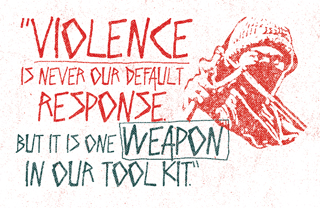
After buying Sutherlin another microwave cheeseburger, I suggested that, while his actions might be appropriate in a society like Nazi Germany, in a democracy like ours, maybe they’re not. But he didn’t buy that; he believes it’s the responsibility of groups like HARM to police the boundary between democracy and fascism, keeping right-wing extremists in check, disorganized and unable to spread their ideas in public or harass people. “We’re not living in a fascist society,” Sutherlin said. “I know that. But it’s happening all around us, in fits and starts.”
As Sutherlin scarfed down a third vending-machine cheeseburger, I asked him about Tony Horwitz’s book Midnight Rising: John Brown and the Raid That Sparked the Civil War, which I’d mailed him. “I feel like that book found me at just the right moment,” he said, a bead of grease dribbling down his chin. We’d been discussing the lesser-known details of Brown’s life, like his murder of slavery advocates at Pottawatomie Creek in Kansas in 1856, and the fact that his raid on Harpers Ferry was widely denounced as fanatical violence, even by President Abraham Lincoln. “I don’t know if we’re headed for a similar moment in American politics,” Sutherlin continued. “But if we are, I want to be someone who did something to stop it, not someone who played it safe and stood by.”
Ten feet away, the guy with the swastika tattoo kissed his son goodbye, and a guard led him away. The brawny, bearded Nazi could have been mistaken for one of Sutherlin’s brothers, the resemblance was so strong.
In January, just before Trump’s inauguration, I spoke with Sutherlin and Telly. All six of the Tinley Park attackers had been released from prison and HARM had gone dormant. Telly lives on the East Coast and has helped create a new group, the Torch Network, which combines several of the most radical ARA chapters, including those in Chicago, Philadelphia, and Central Texas. It promises to be just as militant as ARA, if not more. “New groups call me up and ask for advice,” Telly said. He cited the emergence of anti-fascist groups like the John Brown Militia, Redneck Revolt, and the Bastards Motorcycle Club as reasons to be optimistic, but otherwise he was gloomy. “I don’t know what to tell them,” he said. “We lost. Someone like Trump is what we were trying to prevent from happening.”
“I thought we were being alarmist,” Sutherlin said with a chuckle when I called him at his home outside Bloomington, “but it turns out things were way worse than even we imagined.” He’s no longer on parole and has been lying low, taking care of his six-year-old son and going to anti-Trump rallies but avoiding more militant activism. Since the election, he said, he’d also heard from people who were inspired by his example and seeking his advice. One was a childhood friend, a “gun-loving backwoods survivalist” who had never been political until Trump was elected but recently bought more weapons and talked about defending himself against the radical right wing. “I think a lot of people are now realizing that you can’t be neutral,” Sutherlin said. “A lot of people are suddenly realizing you have to pick a side and go to war.”
